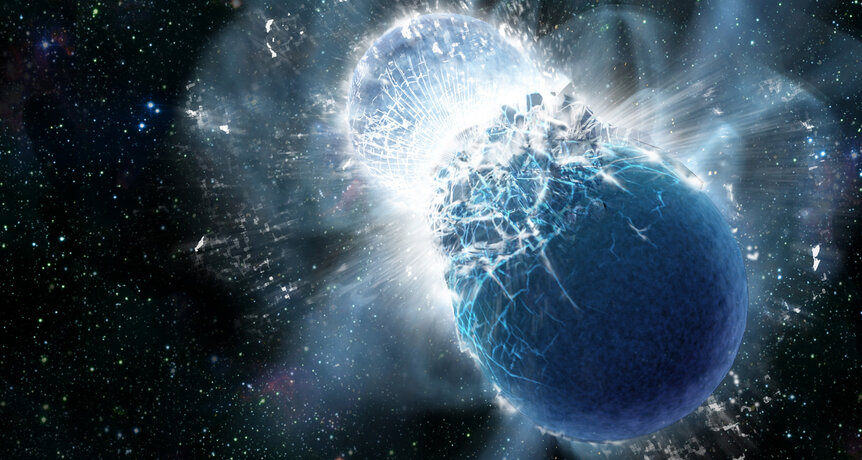Create a free profile to get unlimited access to exclusive videos, sweepstakes, and more!
Astronomers nab the farthest visible explosion from a neutron star collision ever seen

Some quick work by astronomers nabbed the optical flash from a huge explosion caused by two neutron stars colliding nearly three-quarters of the way across the observable Universe. This is the second farthest short gamma-ray burst ever seen, the very farthest visible flash of light from one ever seen, and a rare beast indeed.
Gamma-ray bursts (or GRBs) are some of the most powerful and violent explosions in the cosmos. They were first detected in the 1960s, but their true nature didn't start unfolding until the 1990s, when we learned they were extremely far away and therefore ridiculously powerful. Like, emitting in a few seconds the same energy the Sun will over its entire 12 billion year lifetime powerful.
They come in two flavors: Long (longer than 2 seconds on average) and short (you guessed it: shorter than 2 seconds). Long ones have a number of different sources, but in general come from massive stars exploding as supernovae, and their cores collapse to form black holes. Not every supernova generates a GRB, but when they do the explosion is incredibly energetic, allowing us to see them at vast distances.
Short GRBs involve neutron stars, also the leftover object after a star's core collapses. They're less massive than black holes, but still objects to be reckoned with. If two massive stars orbit each other, they can both explode to form binary neutron stars. Over billions of years they slowly spiral toward each other, then in the last moments they tear each other apart through their fierce gravity and merge, usually forming a black hole. This process generates an intense burst of gamma rays, the highest energy form of light.
This explosion isn't quite as powerful as a supernova, so it's nicknamed a kilonova. Still, quite a bit of energy goes into the blast of light after a merger, which means we can see them from far away.
The short blast of gamma rays is the key to finding them: NASA's Swift observatory is designed specifically to detect GRBs and then train its ultraviolet and optical telescopes on them, nailing down their positions better and alerting telescopes on Earth to take a closer look.
And so it was on 23 November 2018. Swift's Burst Alert Telescope detected a flash of gamma rays lasting about a quarter of a second coming from the direction of the constellation of Coma Berenices. No afterglow was seen by its Ultraviolet/Optical Telescope, though to be fair it's not a very big ‘scope. Swift then sent out an alert, and fast-acting astronomers pointed the huge Gemini telescope at that area of the sky just over 9 hours later, where it saw a feeble glow of near-infrared light (an i magnitude of 25, if you want the tech details, which is faint). It observed again a couple of days later and the glow had faded, confirming it was the GRB afterglow.
Not long after, the mighty Keck telescope took a look at what was now called GRB 181123B (the second GRB detected on 2018 November 23), and was able to take a spectrum of the host galaxy, and astronomers determined it is roughly 10 billion light years from Earth. This makes the GRB the second most distant short one ever seen (GRB 111117A, the current record holder from 2011, was 10.7 billion light years from Earth), and the most distant one with an optical afterglow detected.
Most short GRBs are much closer to us, averaging about 5 billion light years away. Only three are known at about this distance, making GRB 181123B an important marker for studying the Universe at this time.
Around that time of ten billion years ago, galaxies in the Universe were about at their peak of star-birth efficiency, churning out stars at prodigious rates. The host galaxy for this gamma-ray burst is smallish, with about 15 billion times the Sun's mass worth of stars in it (our galaxy, the Milky Way, has about 50 billion solar masses of stars in it), but astronomers determined that at the time it was cranking out about 35 times the Sun's mass in stars every year. That's a lot (currently the Milky Way produces something like 1-2), but about average for galaxies of its size back then, and probably it was already past its peak of star formation.
The reason this is important is because it takes time to make a short GRB. Massive stars blow through their nuclear fuel rapidly, exploding after a dozen million years or so, but it may take billions of years for them to spiral together and collide. This event happened less than 4 billion years after the Big Bang, so that's a hard upper limit on how quickly you can go from making stars to creating a short GRB (and GRB11117A got to the finish line even faster). That tells us a lot about how these events work.
Finding short GRBs at this distance is hard; Swift isn't really designed to see them this far away, so they have to be unusually bright, and even then they're very rare. But the more we find, the better we'll understand this time in the history of the Universe (rather poetically called Cosmic Noon, because so many stars were being made).
It's amazing to me how generous the Universe is sometimes, giving us all these ways to investigate it, including merging neutron stars billions of light years away blasting out high-energy gamma rays for a fraction of a second. It doesn't make things easy… but then where's the fun in that?




























